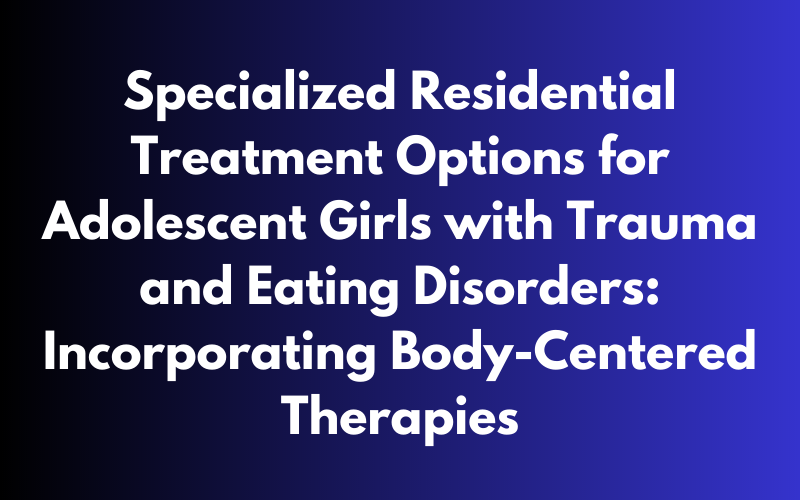When it comes to addressing the complex challenges faced by adolescents with trauma and eating disorders, finding specialized residential treatment options that incorporate body-centered therapies can make all the difference. For parents seeking comprehensive care for their 14-year-old daughters, it’s crucial to explore holistic approaches that focus on both the emotional and physical aspects of healing. In this article, we will delve into the importance of specialized residential treatment for adolescents and how body-centered therapies can contribute to the recovery journey.
Understanding the Need for Specialized Residential Treatment:
Specialized Residential Treatment for Trauma and Eating Disorders:
Are there specialized residential treatment options for your 14-year-old daughter with trauma and eating disorders? The answer is yes. Residential treatment programs offer a safe and structured environment where adolescents can receive intensive care and support. These programs are designed specifically to address the unique needs of individuals struggling with trauma and eating disorders, offering a multidisciplinary approach that combines therapy, medical care, nutrition counseling, and education.
Holistic Approach to Healing:
Incorporating a holistic approach is vital for addressing the interconnected nature of trauma and eating disorders. Specialized residential treatment programs recognize the importance of addressing both the psychological and physical aspects of these conditions. By integrating body-centered therapies, these programs aim to foster a deeper connection between an individual’s mind, body, and emotions, facilitating a comprehensive healing process.
Exploring Body-Centered Therapies:
Expressive Arts Therapies:
Expressive arts therapies, such as dance movement therapy, art therapy, and drama therapy, offer a creative and non-verbal way for adolescents to express their emotions and explore their experiences. By engaging in these therapies, individuals can tap into their body’s wisdom, releasing pent-up emotions, enhancing self-awareness, and promoting healing.
Yoga and Mindfulness Practices:
Yoga and mindfulness practices provide adolescents with valuable tools to manage stress, regulate emotions, and develop a healthier relationship with their bodies. By combining physical movements, breathing techniques, and meditation, these practices help restore balance and promote self-compassion. Incorporating yoga and mindfulness into the treatment plan can empower adolescent girls to reconnect with their bodies and develop a sense of agency over their own well-being.
Somatic Experiencing:
Somatic Experiencing (SE) is a body-centered therapy that focuses on healing trauma by addressing the physiological responses stored in the body. Through gentle and guided awareness of bodily sensations, SE aims to discharge unresolved traumatic energy and restore the natural flow of the nervous system. By incorporating SE into residential treatment, therapists can help adolescents release trauma-related tension, reduce anxiety, and promote emotional regulation.
Conclusion:
When seeking specialized residential treatment options for your 14-year-old daughter with trauma and eating disorders, it’s crucial to consider programs that incorporate body-centered therapies. These holistic approaches provide a comprehensive framework for addressing the emotional and physical aspects of healing. By integrating expressive arts therapies, yoga and mindfulness practices, and somatic experiencing, specialized residential treatment programs can empower adolescents to embark on a transformative recovery journey. Remember, the journey to recovery is unique for each individual, and finding the right treatment approach tailored to your daughter’s needs is essential for her well-being.
Frequently Asked Questions
Are there specialized residential treatment options for adolescents with trauma and eating disorders?
Yes, there are specialized residential treatment options available specifically designed to address the needs of adolescents with trauma and eating disorders. These programs offer comprehensive care and support for individuals in a safe and structured environment.
Can I find residential treatment options that incorporate body-centered therapies for my 14-year-old daughter?
Absolutely! There are residential treatment programs that recognize the importance of body-centered therapies in the recovery journey of adolescents with trauma and eating disorders. These programs integrate approaches such as expressive arts therapies, yoga, mindfulness practices, and somatic experiencing to promote holistic healing.
How do body-centered therapies help in treating trauma and eating disorders?
Body-centered therapies play a crucial role in treating trauma and eating disorders by fostering a deeper connection between an individual’s mind, body, and emotions. These therapies help individuals express their emotions, develop self-awareness, manage stress, regulate emotions, and build a healthier relationship with their bodies.
What are some examples of body-centered therapies used in specialized residential treatment programs?
Specialized residential treatment programs often incorporate various body-centered therapies, such as dance movement therapy, art therapy, drama therapy, yoga, mindfulness practices, and somatic experiencing. These therapies provide unique avenues for adolescents to explore their experiences and promote healing.
Are specialized residential treatment programs effective in addressing trauma and eating disorders in adolescents?
Yes, specialized residential treatment programs have proven to be effective in addressing trauma and eating disorders in adolescents. By providing a comprehensive and supportive environment, these programs offer the necessary tools and therapies to facilitate healing, recovery, and long-term wellness.
How can I find a specialized residential treatment program that incorporates body-centered therapies for my 14-year-old daughter?
To find a specialized residential treatment program that incorporates body-centered therapies for your daughter, you can start by researching reputable treatment centers specializing in trauma and eating disorders. Look for programs that specifically mention the incorporation of body-centered therapies in their treatment approach and reach out to them for more information.
Are specialized residential treatment programs covered by insurance?
The coverage for specialized residential treatment programs varies depending on your insurance provider and policy. It’s important to contact your insurance company to understand the extent of coverage for these types of programs and discuss any potential financial responsibilities.
What other aspects should I consider when choosing a specialized residential treatment program for my daughter with trauma and eating disorders?
When choosing a specialized residential treatment program, consider factors such as the program’s accreditation, the qualifications and experience of the staff, the treatment approach and therapies offered (including body-centered therapies), the success rates of the program, the aftercare support provided, and the overall environment and atmosphere of the facility to ensure it aligns with your daughter’s needs and preferences.
